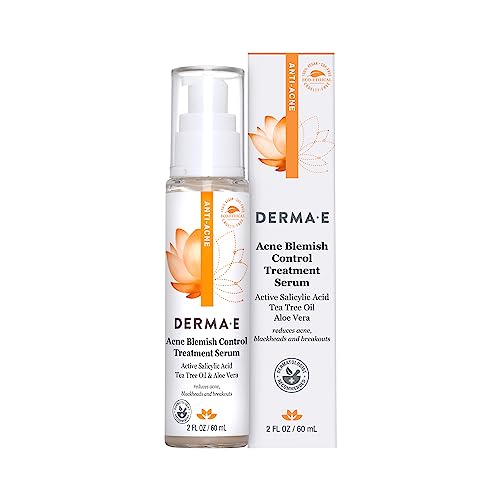


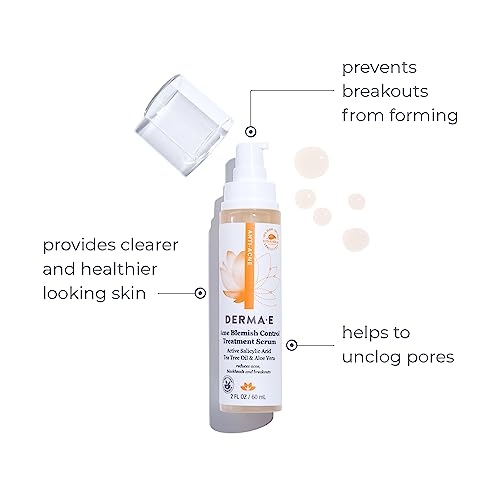
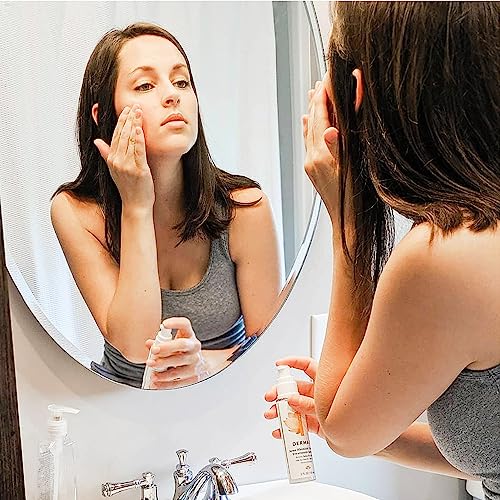
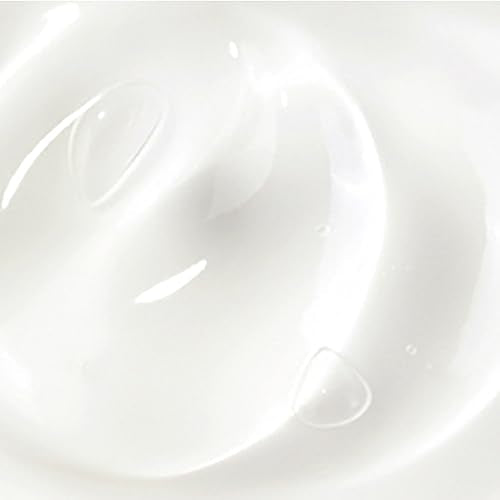
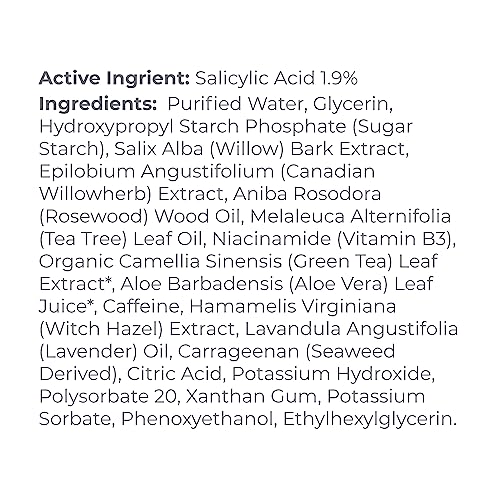
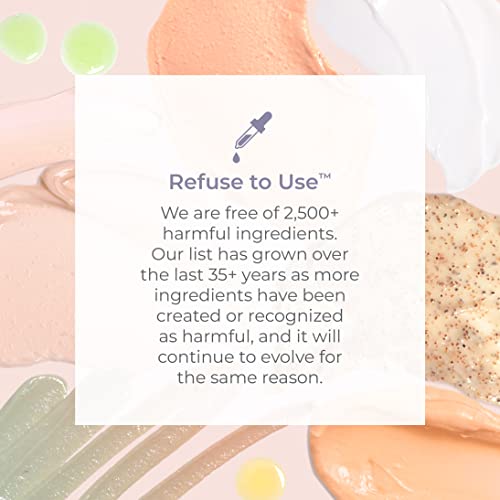
Acne Blemish Control Treatment Serum - 87% Clearer Skin, Award-Winning, Less Toxic Formula - 1oz


Potassium Hydroxide
High RiskPotassium hydroxide is a caustic inorganic base commonly used in various products for its ability to adjust pH levels and act as a cleaning agent. It is highly soluble in water and can produce heat upon dissolution, making it effective in certain formulations.
Sustai Insights
Potassium hydroxide serves as a strong pH adjuster and cleaning agent, but it poses significant health risks due to its caustic nature, which can cause irritation to skin and eyes. Environmental concerns include its potential to contribute to water pollution. Regulatory bodies have imposed strict usage restrictions due to these hazards, leading to a high-risk overall assessment. Safe handling practices are essential, and alternatives such as citric acid may provide safer pH adjustment without the associated risks.
Aniba Rosaeodora (Rosewood) Oil
High RiskAniba rosaeodora (rosewood) oil is an essential oil derived from the rosewood tree, primarily used for its aromatic properties in perfumery and cosmetics. It serves as a fragrance component and may also possess certain skin-conditioning benefits.
Sustai Insights
Rosewood oil offers functional benefits in fragrance applications and is sometimes sustainably sourced. However, it has a high allergenic potential and is associated with non-reproductive organ system toxicity. Regulatory bodies have imposed restrictions on its use due to these health concerns. Environmental risks include potential pollution and bioaccumulation. Overall, the risk level for this ingredient is high, necessitating caution in its use, particularly by vulnerable populations. Alternatives such as synthetic fragrances or other essential oils with lower risk profiles may be considered.
Salicylic Acid
High RiskSalicylic acid is a naturally occurring and synthetic compound primarily used in skincare products for its ability to exfoliate skin, unclog pores, and treat acne. It is a beta hydroxy acid (BHA) that penetrates the skin to effectively reduce inflammation and promote cell turnover.
Sustai Insights
Salicylic acid is recognized for its effective acne treatment properties and ability to enhance skin absorption, making it beneficial in various formulations. However, its use is subject to restrictions due to potential adverse health effects such as skin irritation and enhanced absorption risks. Regulatory bodies have cautioned against high concentrations, marking it as a high-risk ingredient. Special consideration should be given to sensitive populations, and safer alternatives like glycolic acid may be explored to minimize risks.
Camellia Sinensis (Green Tea) Leaf Extract
Medium RiskCamellia sinensis (green tea) leaf extract is derived from the leaves of the Camellia sinensis plant, primarily known for its antioxidant properties. It is commonly used in cosmetic formulations for its potential to soothe the skin and provide protective benefits against environmental stressors.
Sustai Insights
Camellia sinensis leaf extract offers functional benefits, including antioxidant properties that may protect the skin from damage and enhance product efficacy. While generally regarded as safe, it presents moderate allergenic potential and low concerns for carcinogenic or reproductive toxicity. Environmental risks are minimal; however, the sourcing practices should be evaluated for sustainability. Regulatory bodies do not impose significant restrictions, indicating a low-risk profile overall. Safe usage practices are advisable, and alternatives include other botanical extracts with similar benefits.
Melaleuca Alternifolia (Tea Tree) Leaf Oil
Medium RiskMelaleuca alternifolia (tea tree) leaf oil is derived from the leaves of the Melaleuca alternifolia tree. It is commonly used in personal care products for its antiseptic and antimicrobial properties, making it a popular ingredient for skincare formulations.
Sustai Insights
Tea tree leaf oil offers functional benefits, including antimicrobial properties that can help with skin conditions. However, it has a high allergenic potential and may cause skin irritation or allergic reactions in sensitive individuals. Additionally, while it poses low to moderate risks concerning endocrine disruption and reproductive toxicity, it is restricted in certain formulations. Overall, the ingredient is assessed as medium risk, necessitating careful usage and consideration of alternatives for sensitive populations.
Glycerin
Medium RiskGlycerin (also called glycerol) is a naturally occurring compound commonly used in personal care and cosmetic products. It functions as a humectant, attracting moisture to the skin, and is also utilized as a solvent and emollient to enhance product texture and stability.
Sustai Insights
Glycerin is valued for its effective moisturizing properties and biodegradability, making it a widely accepted ingredient in formulations. It poses low health risks, including low concerns for carcinogenicity and allergies. However, moderate use restrictions exist due to regulatory guidelines. While glycerin does not significantly contribute to environmental pollution, its production process should be ethically sourced. Overall, glycerin holds a medium risk level, emphasizing the importance of safe usage practices and considering sustainable alternatives.
Citric Acid
Medium RiskCitric acid is an alpha hydroxy acid used in personal care products primarily for its role as a pH adjuster and natural preservative. It occurs naturally in citrus fruits and is commonly utilized in various formulations for its chelating properties and mild exfoliation benefits.
Sustai Insights
Citric acid offers functional benefits as an effective preservative and pH stabilizer, contributing to product longevity and stability. It is biodegradable and derived from renewable sources. Health risks are low, with minimal concerns regarding carcinogenicity, allergies, and reproductive toxicity. However, moderate use restrictions exist due to potential irritation at high concentrations. Environmental risks are limited, as citric acid is not known to accumulate in ecosystems. Regulatory agencies have no significant advisories against its use. Overall, it is assessed as a medium-risk ingredient, with safe usage practices recommended and alternatives available.
Phenoxyethanol
Medium RiskPhenoxyethanol is a preservative used in cosmetics and personal care products to prevent microbial growth and extend shelf life. It is commonly found in formulations such as lotions, creams, and serums.
Sustai Insights
Phenoxyethanol serves effectively as a preservative, ensuring product stability and safety by inhibiting microbial growth. It is considered to have low health risks regarding carcinogenicity, allergies, and reproductive toxicity. However, moderate use restrictions exist, and regulatory bodies have advised caution in specific applications. Environmental concerns include its potential as a pollutant, although it is not highly bioaccumulative. Overall, the ingredient presents a medium risk level, with safe usage practices recommended and alternative preservatives available for those seeking greener options.
Potassium Sorbate
Medium RiskPotassium sorbate is a potassium salt of sorbic acid, primarily used as a preservative in food and cosmetic products. It inhibits the growth of molds, yeast, and some bacteria, extending the shelf life of products. It is commonly found in various formulations due to its effectiveness and low toxicity.
Sustai Insights
Potassium sorbate serves as an effective preservative, preventing microbial growth in food and cosmetic products, which is vital for safety and longevity. Although it has a low risk of carcinogenicity and developmental toxicity, there is a moderate concern regarding allergies and immunotoxicity. Environmentally, it poses minimal risks as it is not significantly bioaccumulative. Regulatory agencies have verified its use, although some products may face restrictions. Overall, it is assessed as a medium risk ingredient, with safe usage practices recommended, and alternatives such as natural preservatives could be considered.
Hydroxypropyl Starch Phosphate
Low RiskHydroxypropyl starch phosphate is a modified starch derivative used in cosmetic formulations primarily as a thickening agent and film former. It enhances the texture and stability of products, contributing to a desirable sensory experience without altering the product's fundamental properties.
Sustai Insights
Hydroxypropyl starch phosphate offers functional benefits such as effective thickening and stabilization in cosmetic products. It has low health risks, with minimal concerns regarding carcinogenicity, allergies, or reproductive toxicity. Environmentally, it poses low risks of pollution or bioaccumulation, and it is not subject to significant regulatory restrictions. Overall, the risk level associated with this ingredient is low, making it a suitable option in formulations. Safe usage practices should be followed, and alternatives may include other modified starches or natural thickeners.
Hamamelis Virginiana (Witch Hazel) Extract
Low RiskHamamelis virginiana (witch hazel) extract is derived from the bark and leaves of the witch hazel plant. It is commonly used in cosmetic products for its astringent properties, helping to tighten skin and reduce irritation. The extract is recognized for its soothing effects on the skin.
Sustai Insights
Witch hazel extract provides functional benefits as an astringent, helping to minimize skin irritation and enhance skin appearance. It is generally considered low risk for health concerns, with minimal evidence of carcinogenicity, allergenic potential, or reproductive toxicity. Environmental impact is also low, as it does not significantly contribute to pollution or bioaccumulation. Regulatory bodies have not issued major warnings, supporting its safety for use in cosmetics. For safe usage, it is recommended to avoid contact with eyes and to use in appropriate concentrations. Overall, it is regarded as a low-risk ingredient.
Epilobium Angustifolium (Willow Herb) Extract
Low RiskEpilobium angustifolium extract is derived from the leaves and flowers of the willow herb plant, commonly used in cosmetics for its soothing and anti-inflammatory properties. It is often incorporated into formulations aimed at calming irritated skin and promoting overall skin health.
Sustai Insights
Epilobium angustifolium extract provides functional benefits such as anti-inflammatory and soothing effects, making it valuable in skin care. It is sustainably sourced and poses low health risks, including minimal concerns regarding carcinogenicity, allergies, and reproductive toxicity. Environmentally, it is not classified as a pollutant. Regulatory status indicates no current restrictions. Overall, the ingredient is assessed as low risk, with safe usage practices recommended. Alternatives may include other plant extracts with similar soothing properties.
Salix Alba (White Willow) Bark Extract
Low RiskSalix alba (white willow) bark extract is an extract derived from the bark of the white willow tree. It is primarily known for its use in various cosmetic and personal care products, where it functions as an anti-inflammatory and soothing agent.
Sustai Insights
Salix alba bark extract offers functional benefits such as anti-inflammatory properties, which can aid in skin soothing and irritation reduction. It is generally considered low risk regarding health concerns, including carcinogenicity and allergies. Regulatory bodies, including the FDA, have not flagged it for significant health risks. Environmentally, it does not contribute substantially to pollution or bioaccumulation. Overall, this ingredient is assessed as low risk, with safe usage practices recommended. Alternatives can include other plant-based extracts with similar properties.
Lavandula Angustifolia (Lavender) Oil
Low RiskLavandula angustifolia (lavender) oil is a volatile oil derived from the flowers of the lavender plant. It is commonly used in cosmetic and personal care products for its fragrance and potential calming properties.
Sustai Insights
Lavender oil offers functional benefits such as providing fragrance and potential relaxation effects. It is biodegradable and often sustainably sourced. Health risks are minimal, with low concerns for carcinogenicity, allergies, or reproductive toxicity; however, there is a low to moderate concern regarding endocrine disruption. Environmental risks are low, with no significant pollutant or bioaccumulation potential noted. Regulatory status is favorable, with no current restrictions. Safe usage practices include avoiding excessive concentrations, especially in sensitive applications. Overall, the risk level associated with lavender oil is assessed as low.
Niacinamide
Low RiskNiacinamide, also known as nicotinamide, is a form of vitamin B3 (niacin) that serves various functions in skincare and cosmetic products. It is often used for its potential benefits in improving skin texture, enhancing moisture retention, and supporting the skin's barrier function.
Sustai Insights
Niacinamide provides functional benefits such as enhancing skin hydration and improving the appearance of uneven skin tone. It is generally recognized as safe, with low concerns regarding carcinogenicity, allergies, or reproductive toxicity. However, enhanced skin absorption may pose risks for sensitive individuals. Regulatory bodies impose few restrictions on its use, and it is considered low risk overall. For safer alternatives, options like panthenol may be considered. Overall, niacinamide is a low-risk ingredient when used appropriately.
Chondrus Crispus (Carrageenan)
Low RiskChondrus crispus, commonly known as carrageenan, is a gelatinous polysaccharide derived from red algae. It is primarily used as a thickening, stabilizing, and gelling agent in food, cosmetics, and pharmaceuticals, providing texture and consistency to various products.
Sustai Insights
Carrageenan offers functional benefits such as effective thickening and stabilizing properties, making it valuable in food and cosmetic formulations. It is considered to have low health risk concerns regarding carcinogenicity, allergies, and reproductive toxicity, though moderate concerns exist for non-reproductive organ toxicity. Environmental impacts are minimal, as it is not known to be bioaccumulative or a significant pollutant. Regulatory bodies have not issued specific restrictions against its use, affirming a low overall risk assessment for this ingredient. Alternatives like agar-agar or pectin may be considered for those seeking substitutes.
Caffeine
Low RiskCaffeine is a heterocyclic organic compound commonly found in coffee, tea, and various other plants. It acts as a central nervous system stimulant, temporarily warding off drowsiness and restoring alertness. In cosmetic applications, it is often included for its purported benefits in enhancing skin absorption and reducing the appearance of puffiness.
Sustai Insights
Caffeine offers functional benefits such as enhancing skin absorption and providing a stimulating effect. It is generally regarded as safe with low concerns regarding carcinogenicity, allergies, or developmental toxicity. Environmental risks include potential bioaccumulation, though overall it poses low risk based on current scientific consensus. Regulatory bodies have minimal restrictions, but care should be taken regarding enhanced skin absorption. Alternatives may include other stimulants or natural extracts with similar properties. Overall, caffeine is assessed as low risk.
Water
Low RiskWater is a clear, colorless liquid essential for various biological processes. It serves as a solvent in formulations, facilitating the dissolution of other ingredients and enhancing product texture and application. Additionally, water plays a crucial role in hydration and is a key component in many cosmetic and personal care products.
Sustai Insights
Water is an effective solvent and hydrator, contributing to the texture and efficacy of formulations. It is biodegradable and generally regarded as safe, with low concerns regarding carcinogenicity, allergies, and reproductive toxicity. However, excessive water usage can lead to environmental concerns, particularly regarding resource depletion. Regulatory bodies do not impose restrictions on water use in cosmetics. Overall, the risks associated with water are low, making it a safe and essential ingredient.
Xanthan Gum
Low RiskXanthan gum is a polysaccharide, a sugar-based compound produced by the fermentation of glucose or sucrose. It is commonly used as a thickening agent and stabilizer in various food and cosmetic products due to its ability to improve texture and prevent ingredient separation.
Sustai Insights
Xanthan gum serves effectively as a thickener and stabilizer, enhancing product texture and consistency. It is biodegradable and typically derived from renewable sources, supporting sustainability efforts. Health risks are minimal, with low concerns regarding carcinogenicity, allergies, and reproductive toxicity. Environmental impact is similarly low, posing no significant hazards. Regulatory agencies, including the FDA, regard it as safe for use, with no significant restrictions. Overall, xanthan gum is assessed as low risk, making it a suitable ingredient in formulations.
Ethylhexylglycerin
Low RiskEthylhexylglycerin is a glyceryl ether utilized primarily as a skin-conditioning agent and preservative in cosmetic formulations. It enhances the efficacy of preservatives and serves as a humectant, helping to retain moisture in the skin. This ingredient is commonly found in various personal care products.
Sustai Insights
Ethylhexylglycerin offers functional benefits as an effective preservative and skin-conditioning agent, contributing to product longevity and moisture retention. Health risks are generally low, with minor concerns regarding allergic contact dermatitis and irritant potential. Environmentally, it poses minimal risks, not being recognized as a pollutant or bioaccumulative. Regulatory bodies have imposed few restrictions, indicating its safety for use. Overall, its risk level is assessed as low, making it a viable option in cosmetic formulations. For those seeking alternatives, ingredients like propanediol may serve similar functions with potentially lower irritation profiles.
Aloe Barbadensis (Aloe Vera) Leaf Juice
Low RiskAloe barbadensis (aloe vera) leaf juice is derived from the succulent aloe vera plant, known for its hydrating and soothing properties. It is commonly used in cosmetic formulations for its moisturizing effects and is often included in products aimed at skin care and healing.
Sustai Insights
Aloe vera leaf juice offers functional benefits as a moisturizer and skin soothing agent, while being sustainably sourced and biodegradable. Health risks are low, with minimal concerns regarding carcinogenicity, allergies, and reproductive toxicity. Environmental impact is also low, with no significant pollutants identified. Regulatory agencies impose few restrictions. Overall, the ingredient poses a low risk, making it a favorable choice in cosmetic formulations.
Hydroxypropyl Starch Phosphate
Low RiskHydroxypropyl starch phosphate is a modified starch derivative used in cosmetic formulations primarily as a thickening agent and film former. It enhances the texture and stability of products, contributing to a desirable sensory experience without altering the product's fundamental properties.
Sustai Insights
Hydroxypropyl starch phosphate offers functional benefits such as effective thickening and stabilization in cosmetic products. It has low health risks, with minimal concerns regarding carcinogenicity, allergies, or reproductive toxicity. Environmentally, it poses low risks of pollution or bioaccumulation, and it is not subject to significant regulatory restrictions. Overall, the risk level associated with this ingredient is low, making it a suitable option in formulations. Safe usage practices should be followed, and alternatives may include other modified starches or natural thickeners.
Camellia Sinensis (Green Tea) Leaf Extract
Medium RiskCamellia sinensis (green tea) leaf extract is derived from the leaves of the Camellia sinensis plant, primarily known for its antioxidant properties. It is commonly used in cosmetic formulations for its potential to soothe the skin and provide protective benefits against environmental stressors.
Sustai Insights
Camellia sinensis leaf extract offers functional benefits, including antioxidant properties that may protect the skin from damage and enhance product efficacy. While generally regarded as safe, it presents moderate allergenic potential and low concerns for carcinogenic or reproductive toxicity. Environmental risks are minimal; however, the sourcing practices should be evaluated for sustainability. Regulatory bodies do not impose significant restrictions, indicating a low-risk profile overall. Safe usage practices are advisable, and alternatives include other botanical extracts with similar benefits.
Potassium Hydroxide
High RiskPotassium hydroxide is a caustic inorganic base commonly used in various products for its ability to adjust pH levels and act as a cleaning agent. It is highly soluble in water and can produce heat upon dissolution, making it effective in certain formulations.
Sustai Insights
Potassium hydroxide serves as a strong pH adjuster and cleaning agent, but it poses significant health risks due to its caustic nature, which can cause irritation to skin and eyes. Environmental concerns include its potential to contribute to water pollution. Regulatory bodies have imposed strict usage restrictions due to these hazards, leading to a high-risk overall assessment. Safe handling practices are essential, and alternatives such as citric acid may provide safer pH adjustment without the associated risks.
Hamamelis Virginiana (Witch Hazel) Extract
Low RiskHamamelis virginiana (witch hazel) extract is derived from the bark and leaves of the witch hazel plant. It is commonly used in cosmetic products for its astringent properties, helping to tighten skin and reduce irritation. The extract is recognized for its soothing effects on the skin.
Sustai Insights
Witch hazel extract provides functional benefits as an astringent, helping to minimize skin irritation and enhance skin appearance. It is generally considered low risk for health concerns, with minimal evidence of carcinogenicity, allergenic potential, or reproductive toxicity. Environmental impact is also low, as it does not significantly contribute to pollution or bioaccumulation. Regulatory bodies have not issued major warnings, supporting its safety for use in cosmetics. For safe usage, it is recommended to avoid contact with eyes and to use in appropriate concentrations. Overall, it is regarded as a low-risk ingredient.
Epilobium Angustifolium (Willow Herb) Extract
Low RiskEpilobium angustifolium extract is derived from the leaves and flowers of the willow herb plant, commonly used in cosmetics for its soothing and anti-inflammatory properties. It is often incorporated into formulations aimed at calming irritated skin and promoting overall skin health.
Sustai Insights
Epilobium angustifolium extract provides functional benefits such as anti-inflammatory and soothing effects, making it valuable in skin care. It is sustainably sourced and poses low health risks, including minimal concerns regarding carcinogenicity, allergies, and reproductive toxicity. Environmentally, it is not classified as a pollutant. Regulatory status indicates no current restrictions. Overall, the ingredient is assessed as low risk, with safe usage practices recommended. Alternatives may include other plant extracts with similar soothing properties.
Salix Alba (White Willow) Bark Extract
Low RiskSalix alba (white willow) bark extract is an extract derived from the bark of the white willow tree. It is primarily known for its use in various cosmetic and personal care products, where it functions as an anti-inflammatory and soothing agent.
Sustai Insights
Salix alba bark extract offers functional benefits such as anti-inflammatory properties, which can aid in skin soothing and irritation reduction. It is generally considered low risk regarding health concerns, including carcinogenicity and allergies. Regulatory bodies, including the FDA, have not flagged it for significant health risks. Environmentally, it does not contribute substantially to pollution or bioaccumulation. Overall, this ingredient is assessed as low risk, with safe usage practices recommended. Alternatives can include other plant-based extracts with similar properties.
Lavandula Angustifolia (Lavender) Oil
Low RiskLavandula angustifolia (lavender) oil is a volatile oil derived from the flowers of the lavender plant. It is commonly used in cosmetic and personal care products for its fragrance and potential calming properties.
Sustai Insights
Lavender oil offers functional benefits such as providing fragrance and potential relaxation effects. It is biodegradable and often sustainably sourced. Health risks are minimal, with low concerns for carcinogenicity, allergies, or reproductive toxicity; however, there is a low to moderate concern regarding endocrine disruption. Environmental risks are low, with no significant pollutant or bioaccumulation potential noted. Regulatory status is favorable, with no current restrictions. Safe usage practices include avoiding excessive concentrations, especially in sensitive applications. Overall, the risk level associated with lavender oil is assessed as low.
Niacinamide
Low RiskNiacinamide, also known as nicotinamide, is a form of vitamin B3 (niacin) that serves various functions in skincare and cosmetic products. It is often used for its potential benefits in improving skin texture, enhancing moisture retention, and supporting the skin's barrier function.
Sustai Insights
Niacinamide provides functional benefits such as enhancing skin hydration and improving the appearance of uneven skin tone. It is generally recognized as safe, with low concerns regarding carcinogenicity, allergies, or reproductive toxicity. However, enhanced skin absorption may pose risks for sensitive individuals. Regulatory bodies impose few restrictions on its use, and it is considered low risk overall. For safer alternatives, options like panthenol may be considered. Overall, niacinamide is a low-risk ingredient when used appropriately.
Aniba Rosaeodora (Rosewood) Oil
High RiskAniba rosaeodora (rosewood) oil is an essential oil derived from the rosewood tree, primarily used for its aromatic properties in perfumery and cosmetics. It serves as a fragrance component and may also possess certain skin-conditioning benefits.
Sustai Insights
Rosewood oil offers functional benefits in fragrance applications and is sometimes sustainably sourced. However, it has a high allergenic potential and is associated with non-reproductive organ system toxicity. Regulatory bodies have imposed restrictions on its use due to these health concerns. Environmental risks include potential pollution and bioaccumulation. Overall, the risk level for this ingredient is high, necessitating caution in its use, particularly by vulnerable populations. Alternatives such as synthetic fragrances or other essential oils with lower risk profiles may be considered.
Chondrus Crispus (Carrageenan)
Low RiskChondrus crispus, commonly known as carrageenan, is a gelatinous polysaccharide derived from red algae. It is primarily used as a thickening, stabilizing, and gelling agent in food, cosmetics, and pharmaceuticals, providing texture and consistency to various products.
Sustai Insights
Carrageenan offers functional benefits such as effective thickening and stabilizing properties, making it valuable in food and cosmetic formulations. It is considered to have low health risk concerns regarding carcinogenicity, allergies, and reproductive toxicity, though moderate concerns exist for non-reproductive organ toxicity. Environmental impacts are minimal, as it is not known to be bioaccumulative or a significant pollutant. Regulatory bodies have not issued specific restrictions against its use, affirming a low overall risk assessment for this ingredient. Alternatives like agar-agar or pectin may be considered for those seeking substitutes.
Melaleuca Alternifolia (Tea Tree) Leaf Oil
Medium RiskMelaleuca alternifolia (tea tree) leaf oil is derived from the leaves of the Melaleuca alternifolia tree. It is commonly used in personal care products for its antiseptic and antimicrobial properties, making it a popular ingredient for skincare formulations.
Sustai Insights
Tea tree leaf oil offers functional benefits, including antimicrobial properties that can help with skin conditions. However, it has a high allergenic potential and may cause skin irritation or allergic reactions in sensitive individuals. Additionally, while it poses low to moderate risks concerning endocrine disruption and reproductive toxicity, it is restricted in certain formulations. Overall, the ingredient is assessed as medium risk, necessitating careful usage and consideration of alternatives for sensitive populations.
Salicylic Acid
High RiskSalicylic acid is a naturally occurring and synthetic compound primarily used in skincare products for its ability to exfoliate skin, unclog pores, and treat acne. It is a beta hydroxy acid (BHA) that penetrates the skin to effectively reduce inflammation and promote cell turnover.
Sustai Insights
Salicylic acid is recognized for its effective acne treatment properties and ability to enhance skin absorption, making it beneficial in various formulations. However, its use is subject to restrictions due to potential adverse health effects such as skin irritation and enhanced absorption risks. Regulatory bodies have cautioned against high concentrations, marking it as a high-risk ingredient. Special consideration should be given to sensitive populations, and safer alternatives like glycolic acid may be explored to minimize risks.
Caffeine
Low RiskCaffeine is a heterocyclic organic compound commonly found in coffee, tea, and various other plants. It acts as a central nervous system stimulant, temporarily warding off drowsiness and restoring alertness. In cosmetic applications, it is often included for its purported benefits in enhancing skin absorption and reducing the appearance of puffiness.
Sustai Insights
Caffeine offers functional benefits such as enhancing skin absorption and providing a stimulating effect. It is generally regarded as safe with low concerns regarding carcinogenicity, allergies, or developmental toxicity. Environmental risks include potential bioaccumulation, though overall it poses low risk based on current scientific consensus. Regulatory bodies have minimal restrictions, but care should be taken regarding enhanced skin absorption. Alternatives may include other stimulants or natural extracts with similar properties. Overall, caffeine is assessed as low risk.
Water
Low RiskWater is a clear, colorless liquid essential for various biological processes. It serves as a solvent in formulations, facilitating the dissolution of other ingredients and enhancing product texture and application. Additionally, water plays a crucial role in hydration and is a key component in many cosmetic and personal care products.
Sustai Insights
Water is an effective solvent and hydrator, contributing to the texture and efficacy of formulations. It is biodegradable and generally regarded as safe, with low concerns regarding carcinogenicity, allergies, and reproductive toxicity. However, excessive water usage can lead to environmental concerns, particularly regarding resource depletion. Regulatory bodies do not impose restrictions on water use in cosmetics. Overall, the risks associated with water are low, making it a safe and essential ingredient.
Glycerin
Medium RiskGlycerin (also called glycerol) is a naturally occurring compound commonly used in personal care and cosmetic products. It functions as a humectant, attracting moisture to the skin, and is also utilized as a solvent and emollient to enhance product texture and stability.
Sustai Insights
Glycerin is valued for its effective moisturizing properties and biodegradability, making it a widely accepted ingredient in formulations. It poses low health risks, including low concerns for carcinogenicity and allergies. However, moderate use restrictions exist due to regulatory guidelines. While glycerin does not significantly contribute to environmental pollution, its production process should be ethically sourced. Overall, glycerin holds a medium risk level, emphasizing the importance of safe usage practices and considering sustainable alternatives.
Citric Acid
Medium RiskCitric acid is an alpha hydroxy acid used in personal care products primarily for its role as a pH adjuster and natural preservative. It occurs naturally in citrus fruits and is commonly utilized in various formulations for its chelating properties and mild exfoliation benefits.
Sustai Insights
Citric acid offers functional benefits as an effective preservative and pH stabilizer, contributing to product longevity and stability. It is biodegradable and derived from renewable sources. Health risks are low, with minimal concerns regarding carcinogenicity, allergies, and reproductive toxicity. However, moderate use restrictions exist due to potential irritation at high concentrations. Environmental risks are limited, as citric acid is not known to accumulate in ecosystems. Regulatory agencies have no significant advisories against its use. Overall, it is assessed as a medium-risk ingredient, with safe usage practices recommended and alternatives available.
Xanthan Gum
Low RiskXanthan gum is a polysaccharide, a sugar-based compound produced by the fermentation of glucose or sucrose. It is commonly used as a thickening agent and stabilizer in various food and cosmetic products due to its ability to improve texture and prevent ingredient separation.
Sustai Insights
Xanthan gum serves effectively as a thickener and stabilizer, enhancing product texture and consistency. It is biodegradable and typically derived from renewable sources, supporting sustainability efforts. Health risks are minimal, with low concerns regarding carcinogenicity, allergies, and reproductive toxicity. Environmental impact is similarly low, posing no significant hazards. Regulatory agencies, including the FDA, regard it as safe for use, with no significant restrictions. Overall, xanthan gum is assessed as low risk, making it a suitable ingredient in formulations.
Phenoxyethanol
Medium RiskPhenoxyethanol is a preservative used in cosmetics and personal care products to prevent microbial growth and extend shelf life. It is commonly found in formulations such as lotions, creams, and serums.
Sustai Insights
Phenoxyethanol serves effectively as a preservative, ensuring product stability and safety by inhibiting microbial growth. It is considered to have low health risks regarding carcinogenicity, allergies, and reproductive toxicity. However, moderate use restrictions exist, and regulatory bodies have advised caution in specific applications. Environmental concerns include its potential as a pollutant, although it is not highly bioaccumulative. Overall, the ingredient presents a medium risk level, with safe usage practices recommended and alternative preservatives available for those seeking greener options.
Potassium Sorbate
Medium RiskPotassium sorbate is a potassium salt of sorbic acid, primarily used as a preservative in food and cosmetic products. It inhibits the growth of molds, yeast, and some bacteria, extending the shelf life of products. It is commonly found in various formulations due to its effectiveness and low toxicity.
Sustai Insights
Potassium sorbate serves as an effective preservative, preventing microbial growth in food and cosmetic products, which is vital for safety and longevity. Although it has a low risk of carcinogenicity and developmental toxicity, there is a moderate concern regarding allergies and immunotoxicity. Environmentally, it poses minimal risks as it is not significantly bioaccumulative. Regulatory agencies have verified its use, although some products may face restrictions. Overall, it is assessed as a medium risk ingredient, with safe usage practices recommended, and alternatives such as natural preservatives could be considered.
Ethylhexylglycerin
Low RiskEthylhexylglycerin is a glyceryl ether utilized primarily as a skin-conditioning agent and preservative in cosmetic formulations. It enhances the efficacy of preservatives and serves as a humectant, helping to retain moisture in the skin. This ingredient is commonly found in various personal care products.
Sustai Insights
Ethylhexylglycerin offers functional benefits as an effective preservative and skin-conditioning agent, contributing to product longevity and moisture retention. Health risks are generally low, with minor concerns regarding allergic contact dermatitis and irritant potential. Environmentally, it poses minimal risks, not being recognized as a pollutant or bioaccumulative. Regulatory bodies have imposed few restrictions, indicating its safety for use. Overall, its risk level is assessed as low, making it a viable option in cosmetic formulations. For those seeking alternatives, ingredients like propanediol may serve similar functions with potentially lower irritation profiles.
Aloe Barbadensis (Aloe Vera) Leaf Juice
Low RiskAloe barbadensis (aloe vera) leaf juice is derived from the succulent aloe vera plant, known for its hydrating and soothing properties. It is commonly used in cosmetic formulations for its moisturizing effects and is often included in products aimed at skin care and healing.
Sustai Insights
Aloe vera leaf juice offers functional benefits as a moisturizer and skin soothing agent, while being sustainably sourced and biodegradable. Health risks are low, with minimal concerns regarding carcinogenicity, allergies, and reproductive toxicity. Environmental impact is also low, with no significant pollutants identified. Regulatory agencies impose few restrictions. Overall, the ingredient poses a low risk, making it a favorable choice in cosmetic formulations.
Elevate your skincare routine with the Acne Blemish Control Treatment Serum, designed for those seeking clearer, healthier skin. This award-winning serum harnesses the power of natural ingredients to fight blemishes effectively while being gentle on the environment.
- 87% Clearer Skin: Clinical studies show significant improvement in skin clarity, giving you the confidence you deserve.
- Less Toxic Formulas: With a commitment to avoid over 2,500 harmful ingredients, this serum ensures safety for both you and the planet.
- Easy to Use: Simply apply to affected areas 1-3 times daily after cleansing for optimal results.
- Award Winner: Recognized by BetterNutrition as a standout in natural beauty, reflecting its superior quality and effectiveness.
- Prevention Focused: This serum not only treats current blemishes but also prevents future breakouts, promoting long-term skin health.
Subscribe & Save with Sustai
- Best Price Guarantee: Always enjoy the lowest prices on sustainable home essentials.
- No Surprises: We’ll notify you before shipping. No hidden fees, ever.
- You’re in Charge: Change, pause, or cancel your subscription anytime with ease.
- Eco-Friendly Deliveries: Our grouped shipments mean less packaging and lower emissions.
Join us on a sustainable journey. Special offers for a limited time! Prices and promotions may change.
Recommended Products
Elevate your skincare routine with the Acne Blemish Control Treatment Serum, designed for those seeking clearer, healthier skin. This award-winning serum harnesses the power of natural ingredients to fight blemishes effectively while being gentle on the environment.
- 87% Clearer Skin: Clinical studies show significant improvement in skin clarity, giving you the confidence you deserve.
- Less Toxic Formulas: With a commitment to avoid over 2,500 harmful ingredients, this serum ensures safety for both you and the planet.
- Easy to Use: Simply apply to affected areas 1-3 times daily after cleansing for optimal results.
- Award Winner: Recognized by BetterNutrition as a standout in natural beauty, reflecting its superior quality and effectiveness.
- Prevention Focused: This serum not only treats current blemishes but also prevents future breakouts, promoting long-term skin health.

You can have at most 2 Sustainable Steals products in your cart
Customer Reviews
Customers’ View
Customers generally appreciate the effectiveness of the Acne Treatment Serum, noting significant improvements in their skin clarity. Many users highlight the product's natural and non-toxic ingredients, which align with their eco-friendly and health-conscious values, stating, 'I love the more natural ingredients' and 'the formula smells clean.' The serum's gentle formulation is praised for being suitable for sensitive skin, with one reviewer mentioning it worked well without irritation. Users also commend its easy application and quick absorption, leading to positive results even for those with oily or combination skin. Overall, customers find this product beneficial for achieving clearer skin while supporting their sustainable lifestyle.
AI-generated from the text of customer reviewsThis product has no reviews yet.




